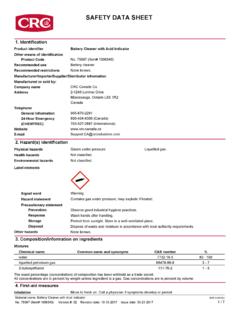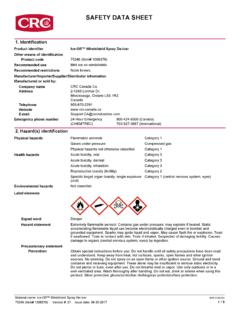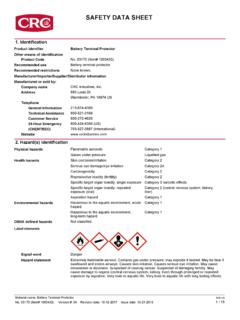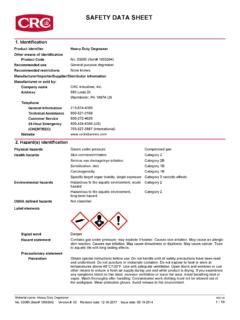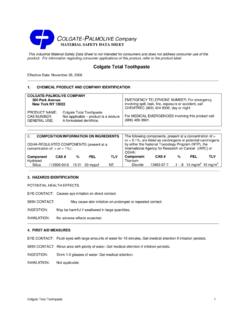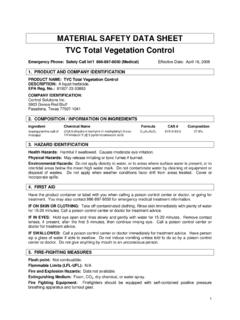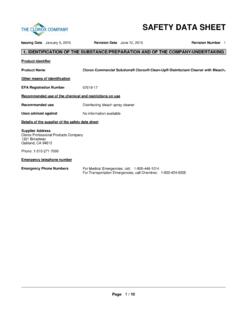Transcription of SAFETY DATA SHEET - CRC Industries
1 SAFETY data SHEET1. IdentificationProduct identifierWasp & Hornet Killer Plus Other means of identificationProduct code14010 Registration numberEPA: 55809-3 Recommended useWasp and hornet insecticideRecommended restrictionsNone informationManufactured or sold by:Company nameCRC Industries , Louis , PA 18974 USTelephoneGeneral Information215-674-4300 TechnicalAssistance800-521-3168 Customer Service800-272-462024-Hour Emergency800-424-9300 (US)(CHEMTREC)703-527-3887 (International) Hazard(s) identificationCategory 1 Flammable aerosolsPhysical hazardsCompressed gasGases under pressureCategory 2 Skin corrosion/irritationHealth hazardsCategory 3 narcotic effectsSpecific target organ toxicity, single exposureCategory 1 Aspiration hazardCategory 1 Hazardous to the aquatic environment, acutehazardEnvironmental hazardsCategory 1 Hazardous to the aquatic environment,long-term hazardNot defined hazardsLabel elementsSignal wordDangerHazard statementExtremely flammable aerosol.
2 Contains gas under pressure; may explode if heated. May be fatal ifswallowed and enters airways. Causes skin irritation. May cause drowsiness or dizziness. Verytoxic to aquatic life. Very toxic to aquatic life with long lasting statementPreventionKeep away from heat/sparks/open flames/hot surfaces. - No smoking. Do not spray on an openflame or other ignition source. Do not apply while equipment is energized. Pressurized container:Do not pierce or burn, even after use. Extinguish all flames, pilot lights and heaters. Vapors willaccumulate readily and may ignite. Use only with adequate ventilation; maintain ventilation duringuse and until all vapors are gone. Open doors and windows or use other means to ensure a freshair supply during use and while product is drying.
3 If you experience any symptoms listed on thislabel, increase ventilation or leave the area. Avoid breathing mist or vapor. Wash thoroughly afterhandling. Wear protective gloves. Avoid release to the / 9 Material name: Wasp & Hornet Killer Plus 14010 Version #: 01 Issue date: 03-11-2015 SDS USResponseIf swallowed: Immediately call a poison center/doctor. Do NOT induce vomiting. If on skin: Washwith plenty of water. If skin irritation occurs: Get medical attention. Take off contaminated clothingand wash before reuse. If inhaled: Remove person to fresh air and keep comfortable forbreathing. Call a poison center/doctor if you feel unwell. Collect in a well-ventilated place. Store locked up. Protect from sunlight. Do not expose totemperatures exceeding 50 C/122 F.
4 Exposure to high temperature may cause can to of contents/container in accordance with local/regional/national (s) not otherwiseclassified (HNOC)None Composition/information on ingredientsMixturesCAS number%Chemical nameCommon name and synonyms64742-47-8 Distillates (petroleum), hydrotreatedlight90 - 100124-38-9 Carbon dioxide1 - chemical identity and/or percentage of composition has been withheld as a trade First-aid measuresInhalationRemove victim to fresh air and keep at rest in a position comfortable for breathing. Call a POISONCENTER or doctor/physician if you feel contactRemove contaminated clothing. Rinse skin with water/shower. If skin irritation occurs: Get medicaladvice/attention. Wash contaminated clothing before contactImmediately flush eyes with plenty of water for at least 15 minutes.
5 Continue rinsing. Removecontact lenses, if present and easy to do. Get medical attention if irritation develops and a physician or poison control center immediately. Rinse mouth. Do not induce vomiting. Ifvomiting occurs, keep head low so that stomach content doesn't get into the lungs. Never giveanything by mouth to a victim who is unconscious or is having importantsymptoms/effects, acute anddelayedMay cause drowsiness and dizziness. Headache. Nausea, vomiting. Aspiration may causepulmonary edema and pneumonitis. Skin irritation. May cause redness and of immediatemedical attention and specialtreatment neededProvide general supportive measures and treat symptomatically. Keep victim under may be informationEnsure that medical personnel are aware of the material(s) involved, and take precautions toprotect Fire-fighting measuresSuitable extinguishing mediaAlcohol resistant foam.
6 Water fog. Dry chemical powder. Dry chemicals. Carbon dioxide (CO2).Unsuitable extinguishingmediaDo not use water jet as an extinguisher, as this will spread the hazards arising fromthe chemicalContents under pressure. Pressurized container may rupture when exposed to heat or fire, gases hazardous to health may be protective equipmentand precautions for firefightersFirefighters must use standard protective equipment including flame retardant coat, helmet withface shield, gloves, rubber boots, and in enclosed spaces, case of fire: Stop leak if safe to do so. Move containers from fire area if you can do so withoutrisk. Cool containers exposed to heat with water spray and remove container, if no risk is should be cooled with water to prevent vapor pressure build fire hazardsExtremely flammable aerosol.
7 Contents under pressure. Pressurized container may rupture whenexposed to heat or / 9 Material name: Wasp & Hornet Killer Plus 14010 Version #: 01 Issue date: 03-11-2015 SDS US6. Accidental release measuresPersonal precautions,protective equipment andemergency proceduresKeep unnecessary personnel away. Keep people away from and upwind of spill/leak. Keep out oflow areas. Many gases are heavier than air and will spread along ground and collect in low orconfined areas (sewers, basements, tanks). Wear appropriate protective equipment and clothingduring clean-up. Avoid breathing mist or vapor. Emergency personnel need self-containedbreathing equipment. Do not touch damaged containers or spilled material unless wearingappropriate protective clothing.
8 Ventilate closed spaces before entering them. Local authoritiesshould be advised if significant spillages cannot be contained. For personal protection, see section8 of the and materials forcontainment and cleaning upEliminate all ignition sources (no smoking, flares, sparks, or flames in immediate area). Keepcombustibles (wood, paper, oil, etc.) away from spilled material. This product is miscible in the flow of material, if this is without risk. Wipe up with absorbent material ( cloth, fleece).Clean surface thoroughly to remove residual contamination. For waste disposal, see section 13 ofthe SDS. Prevent entry into waterways, sewer, basements or confined precautionsAvoid release to the environment. Prevent further leakage or spillage if safe to do so.
9 Avoiddischarge into drains, water courses or onto the ground. Inform appropriate managerial orsupervisory personnel of all environmental Handling and storagePrecautions for safe handlingPressurized container: Do not pierce or burn, even after use. Do not use if spray button is missingor defective. Do not spray on a naked flame or any other incandescent material. Do not smokewhile using or until sprayed surface is thoroughly dry. Do not cut, weld, solder, drill, grind, orexpose containers to heat, flame, sparks, or other sources of ignition. Use caution aroundenergized equipment. The metal container will conduct electricity if it contacts a live source. Thismay result in injury to the user from electrical shock and/or flash fire.
10 Avoid breathing mist orvapor. Avoid contact with eyes, skin, and clothing. Avoid prolonged or repeated contact with prolonged exposure. Use only in well-ventilated areas. Wear appropriate personal protectiveequipment. Wash hands thoroughly after handling. Avoid release to the environment. Observegood industrial hygiene practices. For product usage instructions, please see the product for safe storage,including any incompatibilitiesLevel 3 container. Protect from sunlight and do not expose to temperatures exceeding50 C/122 F. Do not puncture, incinerate or crush. Do not handle or store near an open flame,heat or other sources of ignition. This material can accumulate static charge which may causespark and become an ignition source.


